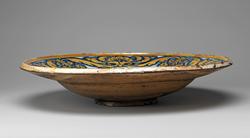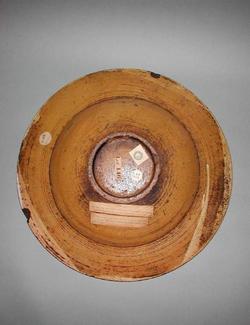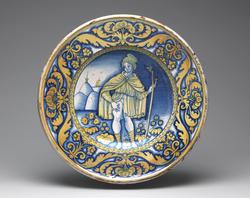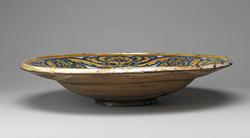Current Location: Gallery 6 (Upper Marlay): case 2, shelf B
Titles
St Roch
Maker(s)
Maker:
Unknown
Entities
Categories
Description
Dark buff earthenware, the front is tin-glazed; the reverse lead-glazed honey-brown. Painted in bright dark blue and with brassy-yellow lustre.
Shape 61. Circular with slightly sloping rim and wide deep well. standing on a footring pierced by two holes in the correct position for suspension the right way up.
In the middle, St Roch leans on a forked staff held in his left hand and points with his right to a plague spot on his right thigh; he has a halo and wears knee-length hose, a short tunic with long sleeves and a cloak. In the background to left, are hills and the towers and spires of two churches, and in the foreground, stylized flowers. The edge of the well has a border of zig-zags and spots. On the rim, there are stylized flowers and scrolling leaves. A band of yellow lustre encircles the outer edge.
Notes
History note: S.R. Christie-Miller; Sotheby's, 28 July 1919, Catalogue of a small but choice collection of Italian majolica, the property of S.R. Christie-Miller, Esq., Britwell Court, Burnham, Bucks., Lot B & pl. IB; F. Leverton Harris.
Legal notes
F. Leverton Harris Bequest, 1926
Measurements and weight
Diameter: 41.8 cm
Height: 9 cm
Acquisition and important dates
Method of acquisition: Bequeathed
(1926)
by
Harris, Frederick Leverton
Dating
16th Century, first half
Renaissance
Circa
1500
-
1550
Note
Label text from the exhibition ‘Madonnas and Miracles: The Holy Home in Renaissance Italy’, on display at The Fitzwilliam Museum from 7 March until 4 June 2017: The threat of plague was ever-present in Renaissance Italy. Those seeking protection from the disease often directed their prayers to Saints Roch and Sebastian. Sebastian, who had survived multiple arrow wounds unharmed, drew the ‘arrows’ of misfortune and illness away from the devout. Roch was a pilgrim and plague victim (as indicated by the ulcer in his thigh), who survived and was believed to offer miraculous cures. The saints appear in many altarpieces, but also in numerous objects and images made for the home, indicating their widespread appeal.
He cult of St Roch (c. 1350-80) as a protector against plague developed slowly in Italy during the late fourteenth and fifteenth centuries. By the sixteenth century he was established as one of the most popular saints. He was frequently depicted in art: alone or accompanied by a dog, in scenes from his life, or with other Saints, especially St Sebastian who was also invoked against pestilence. He is usually dressed as a pilgrim leaning on a staff and indicating the plague boil on his thigh. Apart from being hatless and beardless, the figure on this dish is reminiscent of the St Roch in a detached fresco of 1475, attributed to Fiorenzo di Lorenzo (1965), or to Perugino (1989), formerly in San Francesco, Deruta, and now in the Pinacoteca there. Despite the prevalence of plague, and a particularly virulent outbreak in 1527, Deruta piatti da pompa decorated with St Roch are uncommon in comparison with those decorated with St Francis, the Virgin or other religious subjects. Another lustred dish decorated with St Roch was compared by Galeazzi and Valentini to the style of Spagna (active c. 1504, died 1528) a pupil of Perugino.
School or Style
Renaissance
People, subjects and objects depicted
Components of the work
Decoration
composed of
high-temperature colour
( cobalt-blue)
reduced pigment lustre
( silver-yellow lustre, appearing brassy-yellow)
lead-glaze
tin-glaze
Front
Reverse
Materials used in production
Earthenware
Techniques used in production
Throwing
: Dark buff earthenware, the front is tin-glazed; the reverse lead-glazed honey-brown. Painted in bright dark blue and with brassy-yellow lustre.
Inscription or legends present
Inscription present: rectangular
- Text: Lot 146
- Method of creation: Printed in black
- Type: Label
Inscription present: rectangular with turquoise printed wreath
- Text: '176' in ink, 'Leverton Harris/Bequest 1926'
- Method of creation: Hand-written in ink and in pencil
- Type: Label
Inscription present: rectangular section of a sale catalogue entry in two sections
- Text: DERUTA/DISH with sunk centre, painted with a figure of Saint Roch, showing the/plague spot on his thigh, standing and holding a forked staff in
- Type: Label
Inscription present: rectangular section of a sale catalogue entry in two sections
- Text: the distance a city; broad border of scrolls in yellow, shaded with blue, the centre and border lustred with various metallic tins./Diameter, 16 3/4 in.
- Type: Label
Inscription present: circular
- Text: 'M65/' in ink, 'Leverton Harris Bequest' in pencil
- Method of creation: Inscribed in ink and pencil
- Type: Label
References and bibliographic entries
Related exhibitions
Identification numbers
Accession number: C.45-1927
Primary reference Number: 48512
Stable URI
Audit data
Created: Saturday 6 August 2011
Updated: Tuesday 30 April 2024
Last processed: Wednesday 14 May 2025
Associated departments & institutions
Owner or interested party:
The Fitzwilliam Museum
Associated department:
Applied Arts
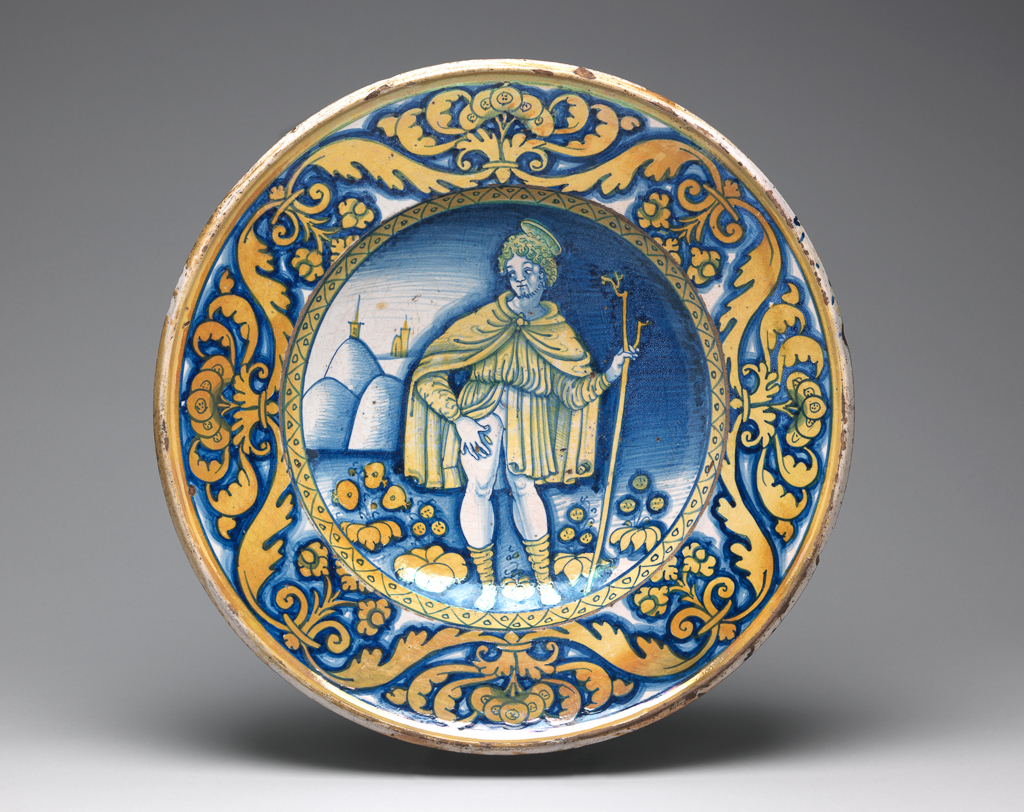
 IIIF Manifest
IIIF Manifest
